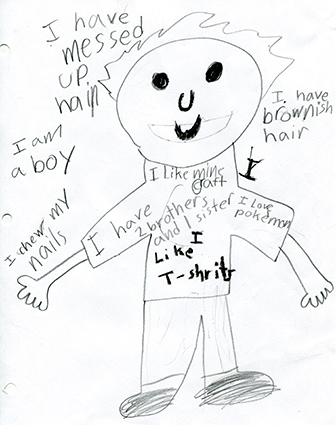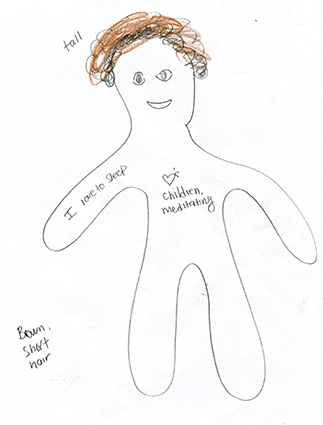
Overview
Students share their own experiences with negative labels and discuss how it feels to be labeled or stereotyped because of a difference. Positive language and other respectful ways of being together are explored. This lesson starts with a general discussion on how language can be used to label and exclude people and moves to review disability etiquette using student-generated materials from the Internet and the class.
Identity and Belonging Focus: Disability and Diversity.
Grade Level(s): 2 through 6.
Subject(s): Reading and Language Arts, Art.
Learning Objectives
- Understand the value of respectful language and behaviors.
- Recognize the impact of negative labels and stereotypes on individuals with disabilities and others.
- Understand differences among individuals and the ways in which attitudes, fears and stereotypes are formed.

Standards
Participate in collaborative conversations with diverse partners about topics and texts with peers and adults in large and small groups.Follow agreed upon rules for discussions (e.g., listening to others with care, speaking one at a time about the topics and texts under discussion).
Identify real life connections between words and their use.
Tell a story or recount an experience with appropriate facts and relevant, descriptive details, speaking audibly in coherent sentences.
Materials
- Post-it notes in two colors, one for negative and the other for positive labels.
- Flip chart and different colored markers.
- Drawing paper and crayons or markers for artwork or signs.
- Computer and Internet links to optional video.
Optional: Puppets or puppet-making materials.
Time: Two 20-minutes sessions.
Setting: Large group and optional small groups.

Directions
Part 1: Identify Positive and Negative Labels
Before moving on to a discussion of negative labels, some teachers will start this lesson by having students share some of the words and nicknames friends and family use to describe them that make them feel appreciated. Others will choose to open this lesson by showing this student film: Karalnick, A. & Dahan, E. I’m Not a Soup Can (Don’t Label Me) (1:01 minutes). After showing the video facilitate a discussion about people being labeled. Ask students if they have felt labeled. Ask for examples and ask how they felt, how they handled it and what would have helped. Give students three to five minutes to create their own “Don’t Label Me!” message on sticky notes and share them with each other. Next, tell students we are going to create a shared list of labels that we want to avoid and identify other more respectful ways to talk about differences. Use a flip chart divided into two columns with different colored markers. Hand out the Wordstorm Worksheet if students will be working in small groups or will be taking notes.
Tell students (working in small groups or together as a class) that we are going to continue to explore the power of words to help or harm. Go back to our own Post-it labels. Using more Post-it notes, have students write down words or phrases that are used to label or stereotype individuals and groups, expanding upon what was started earlier. Next use another color of Post-it notes to write down more respectful ways to describe differences.If disability examples are not offered at first, prompt students to share examples of positive or negative terms they have heard used to describe people with disabilities. Have students post their labels on the positive or negative side of the flip chart. (Sometimes a word or phrase can be identified as both positive and negative. That’s OK: Come back to it later during the large group discussion.) Once the labels are posted, allow students the opportunity to discuss their reasons for identifying specific terms as positive or negative.
Here is a prompt that may be helpful:
Discuss the fact that a word or phrase may be respectful in some situations and not OK in others. For example, a child with red hair may appreciate it when his/her cousin with red hair calls him or her “Carrottop” as a term of endearment. The same term could hurt when used by a classmate in a taunting way or be frustrating when the nickname is unwanted. Students may have their own examples to share.
Ask students to identify a situation when someone paid them a compliment. What was the reason for the compliment? Was the person noticing a skill or talent, positive behavior, or a shared interest? How did it feel to have someone show respect?
Ask students to think about the ways we use words. Sometimes we do not intend to hurt someone; but a word or the way it is used may feel demeaning or hurtful. For example, someone who is sensitive about being short may hate being called “Shorty”; someone else may love the nickname. When one person is described as special, he may feel special; someone else may feel like they are being made to feel like an outsider.
Closing Activity: Students can explore the power of labels through an optional art activity. Have them use one half of the front of the drawing paper to depict how they felt when complimented; and use the other half or the back to depict how they felt when someone used hurtful or uncomfortable comments while talking to or about them.
Part 2: Disability Etiquette
Revisit the Wordstorm Worksheet or put a new version of the group list up, with only the disability words/phrases on the sheet.
Introduce/discuss the idea of “person first” language and why it has become important. Using the flip chart, show students how easy it is to change disability-first language to person-first language. Remind them that you can always talk about the person by name and not use a label at all. Ask students to take a couple of minutes to come up their own examples of ways to talk about disability using person-first language.
Help students understand the importance of respecting how each person with a disability chooses to refer to or name his or her own experience with disability. One person’s preference may be different than others, and it is OK to ask the person what word or phrase he or she prefers. One person may choose to call himself “a person with a disability,” and another may prefer the term “differently-abled.” Students can compare the choices people make about the words they choose to use to describe themselves. The idea is to help students recognize the differences between respectful and harmful language.
Alternative Theater Activity
After creating the lists, have students work in small groups to develop a role-play or puppet show about how to respond when confronted with name-calling/bullying behavior. One choice could be to use mime (no words spoken) and have the words suggested by the action and facial expression of the actors or shown on signs. Older students could create a play and then show it to younger grades as part of a lesson on respectful language.
Lesson Wrapup/Follow-up
Revisit the importance of respectful language and how they relate to communicating with, or about, people with disabilities. Encourage students to talk with their family members about their own experiences with disability or about people they know who have disabilities (family members, friends and characters from television, books or movies).
Supplemental or Alternative Activities
Disability Etiquette: Two student-created films make some good suggestions on how we can use language and other behaviors to show respect for individuals with disabilities: Both could be used with this session. The first, “Don’t talk ABOUT me in front of me,” is presented by a student who uses a communication device to speak, and in the second, a trio of students with and without disabilities gives 10 tips for disability etiquette:
Ten Tips for Kids: Disability Etiquette (9:02 minutes).
Respectful and Person First Language: A brochure with examples of person-first language is posted with this lesson.
Vocabulary: As a follow-up to this activity, select grade level-appropriate words from the “positive” list to utilize as vocabulary/spelling words for the class or for a student’s personal set of reading flash cards.
Follow-up Theater Awareness Activity: Older students could present their role-plays or puppet shows to younger students as part of the implementation of this lesson in a younger grade classroom.
Join the Campaign to Get Rid of the ‘R’ Word: Work with the class to research this campaign on the Internet or identify a guest speaker to come and talk about it. Based on what you learn, students can choose to design and sign a petition, create public awareness posters, letters, and create a PSA to promote awareness and action on this issue in your school and community. For an update on Vermont’s work on this, students can call or email Green Mountain Self-Advocates.
Resources
General Resources
Other websites and videos to view are:
Offense Taken (4:57 minutes).
A great lesson plan on the Teaching Tolerance website, Checking on Stereotypes.